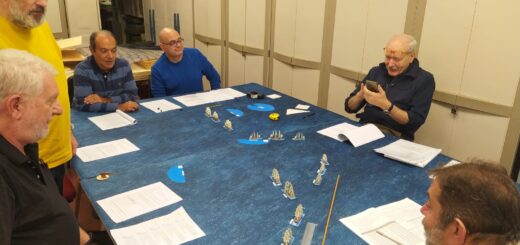Esercito Iraq in 1/300: Gulf War
L’esercito in 6mm
Vorrei preparare tre brigate meccanizzate, di cui una della Guardia Repubblicana. Per ora ho fatto:
- Un comando di brigata BTR60
- Due comandi di battaglione BTR50
- Un comando di battaglione T62M (H&R)
- Un comando di battaglione T55+125+ERA (bello Scotia)
- Un comando di battaglione T55+125+ERA (brutto H&R)
- Un comando di battaglione T72M (Scotia)
- 9 T62M (H&R)
- 6 T55+125+ERA (belli Scotia)
- 3 T55+125+ERA (brutti H&R)
- 6 T72M (Scotia)
- 3 T72+ERA (H&R)
- 9 EE9 APC (H&R)
- 1 AMLH90 recce (H&R)
- 1 AML60 recce (H&R)
- 1 MTK1 mineclearer (Scotia)
- 10 BTR60.
- 3 BRDM3 Spandrel
- 2 SCUD
- 1 FROG
- 2 SA8
- vari radar AA
- 13 Fahd APC.
Da prendere:
- 3 x Type63 con 107mm MRL, le usavano al posto dei mortai da 120mm
- 3 M60 Jugoslav PAC, le usavano per la recce.
Un documento sull’invasione e guerra del golfo dal punto di vista degli iracheni:
Iraqi 6mm infantry
Take it from a Desert Storm, Operation Iraqi Freedom I and Operation Iraqi Freedom ’05-’07 veteran. Use the GHQ Soviets. They all wore Soviet helmets, carried AK-47’s and besides, the uniforms at that scale will be too small to see the difference. Paint their helmets tan and the uniforms a lighter shade of green. Also they web gear would be a mixture of green and tan. I would say 60% tan items to 40% green items is a realistic mixture. Boots were black and only black.
Painting Iraqi tanks
I remember seeing BMPs and other vehicles with a two-color scheme of sand and olive green. The OG is a lighter shade and should be about 1/3 of the vehicle’s surface area in wide bands, about 3 or 4 showing up on the long side of the chasis. At least when I get back into painting my Iraqui armor, that’s how I intend to paint my BMPs. I don’t remeber seeing any of the T-72s wearing this two color scheme, but some of the T-54s may have had it. Since this was from news reports, the unit represented was not given, but it might have been one of the average army divisions like the Nebuchaadnezzer (of various spellings) rather than rebuplican guard units whom I think only had sand colored vehicles or brown primer-only paint jobs covered in dust (the latter mostly in 1991 when they had new vehicles).
From my referance material it shows Iraq used all three. Sand only, sand and green, And sand and brown. Sand and green might have been from up north (former war with iran). Some invasion video shows sand and green armored cars for sure. Hope this helps
Some of the T-59s we ran into were a sort of pale green. I don’t know if it was from fading in the sun or if that was their original color. Probably a combination of both. The sand colors I recall seeing varied. Again, I am not sure if some of the vehicles had been captured Kuwaiti vehicles placed into Iraqi service or if they were organic Iraqi vehicles that just had different colors based on who provided the vehicles to them initially.
Many Iraqi T-72s I saw had various shades of grimy black applied. Especially around entry and exit points
I concur with others here that the color varied greatly for sure. I examined several bring backs and from some experimenting with colors ( on actual color chips ) I discovered that the closest out of the bottle match for the Iraqi sand colors that I saw was Polly S 500827 SAND 30277.
This color once sprayed does have a bit of a green tint look but changes depending on weathering. I also noted on some BMP-1’s that through the chipped paint on them there was an underlying pattern of Dark Green and Brown. The T-59’s were also the same way. At least the ones I examined. Some had broad patches of Dark Green while others were solid Sand.
several Iraqi tanks were finished in a dark tan (card box brown) color. This color was faded by the sun to a nearly light sand. Some vehicles also go into combat with the original russian green camo (also faded by sun….), or received over the sand color black stripes.
A good source is the osprey book “T-72” with several pictures and drawings.
A good equivalent shade can be found using Vallejo, Iraqi sand, number 819, which I developped myself for the company based upon observation of various vehicles. Also I have some good close ups posted in the msn site of a bmp 1 This is one example. The underlying soviet green base colour, shows through and can be simulated using Vallejo Russian Green.
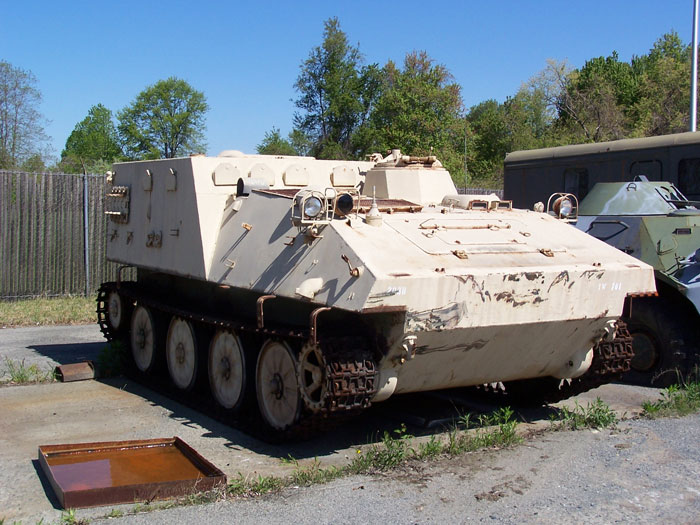
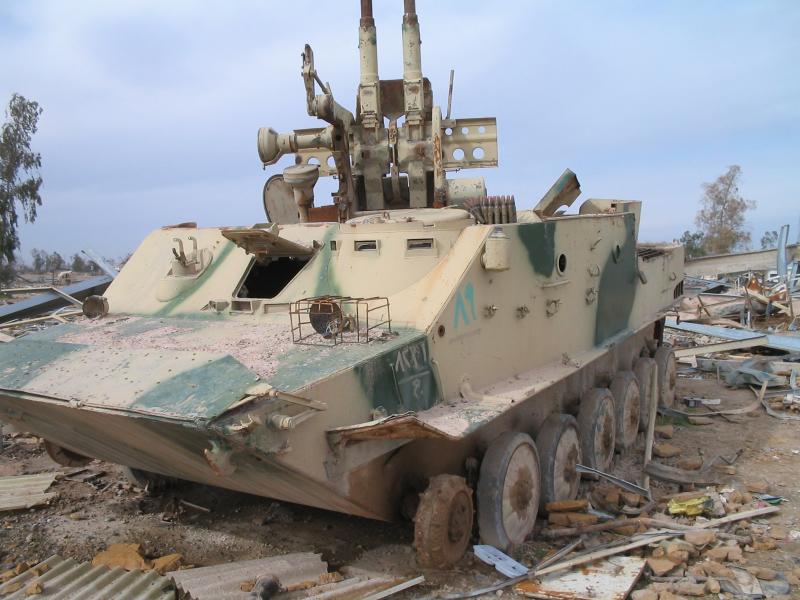
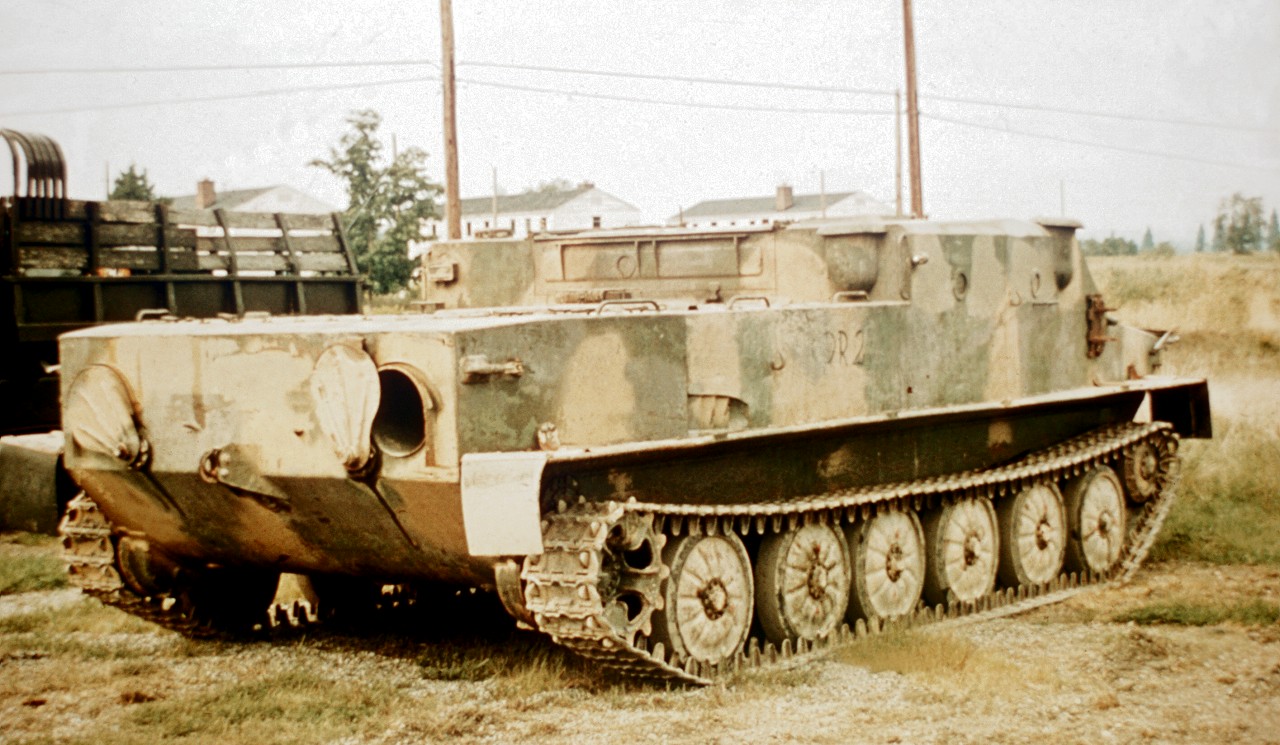
A right rear view of a Soviet BTR-50PK armored personnel carrier. 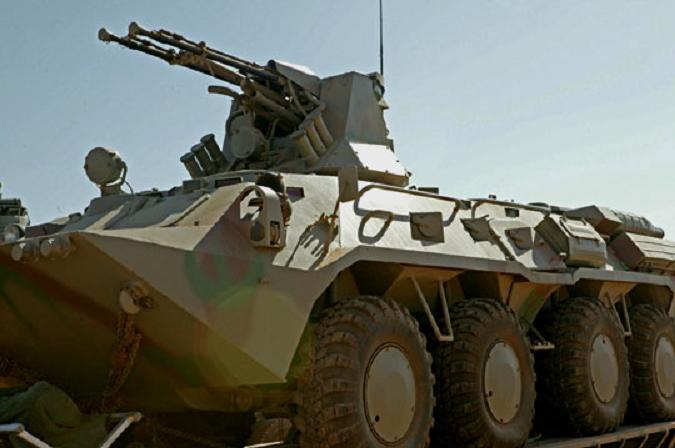
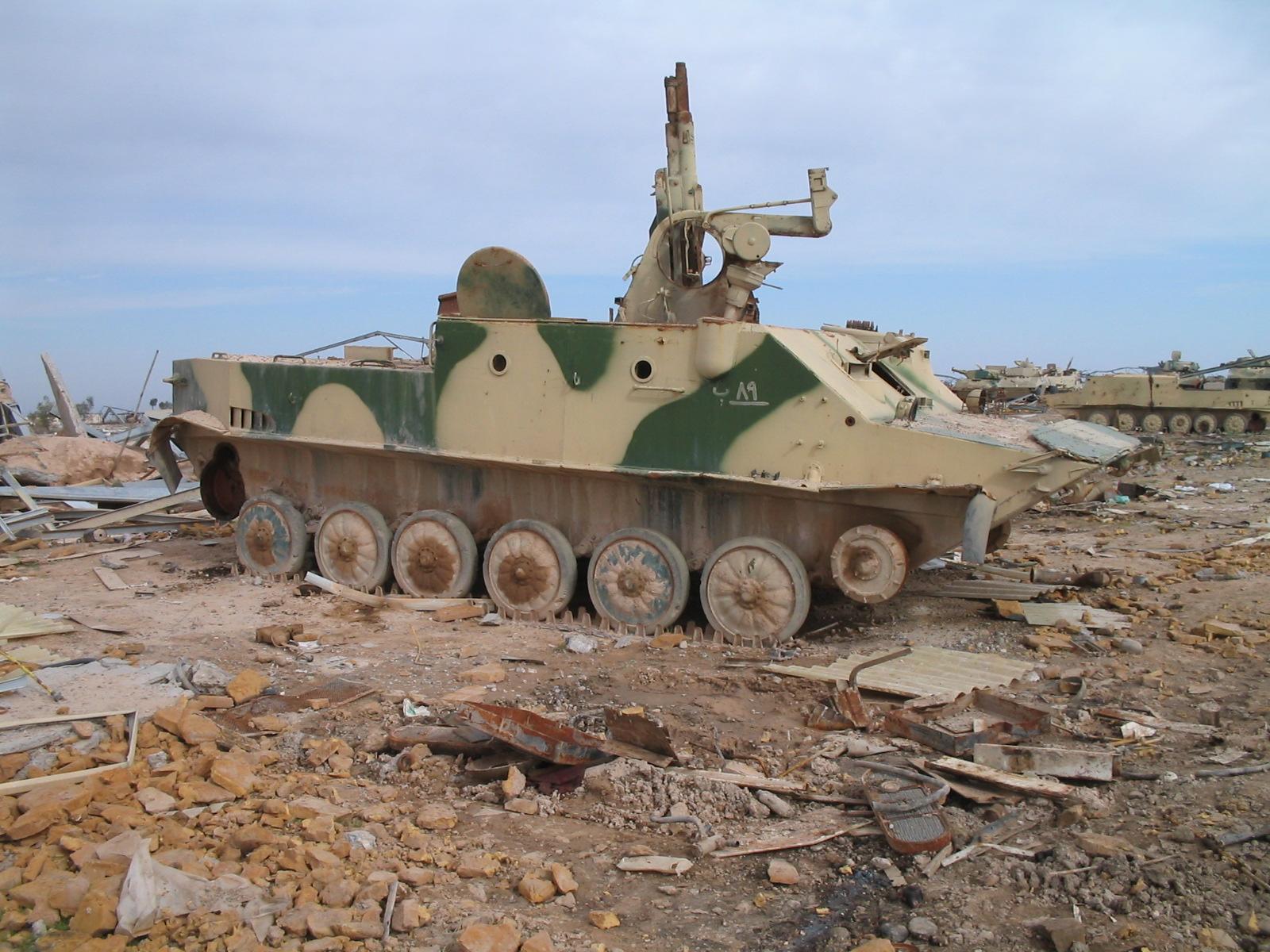
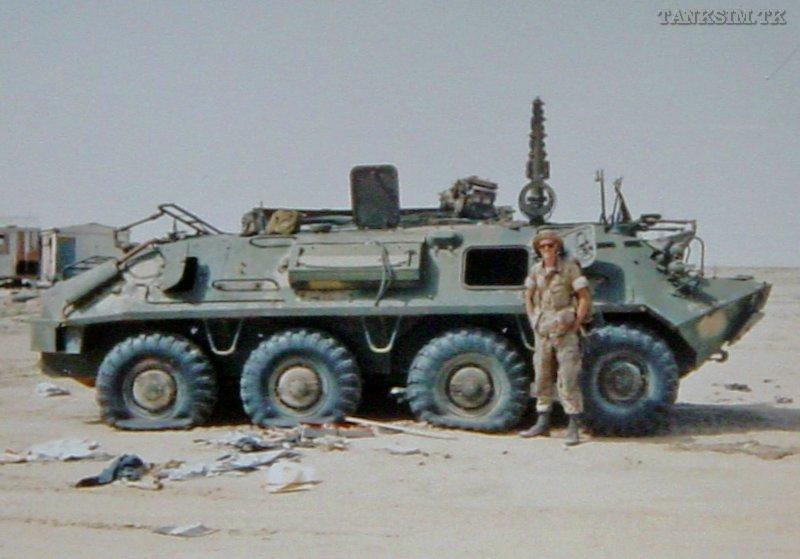
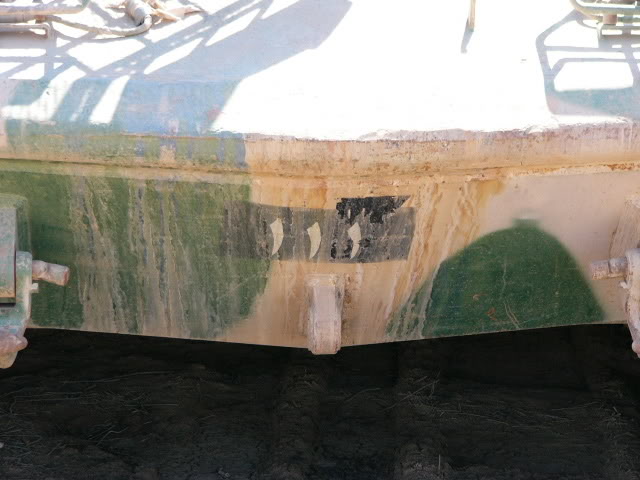
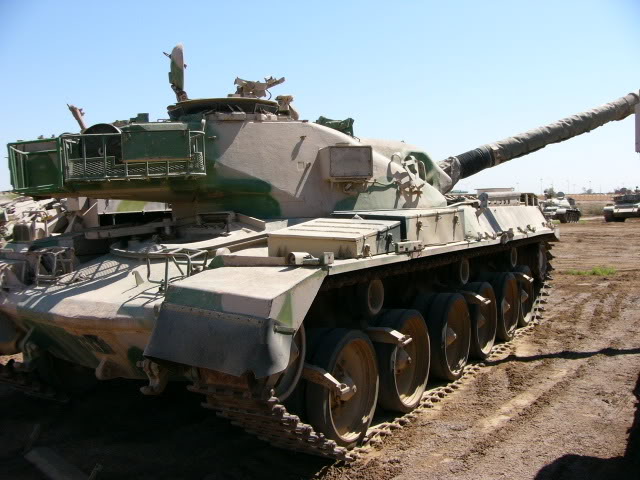
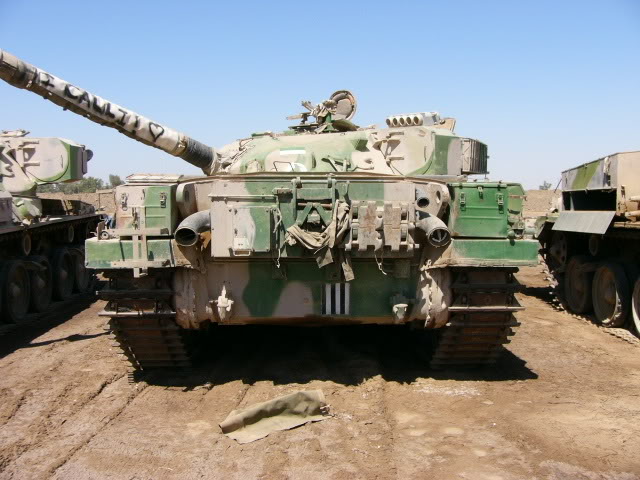
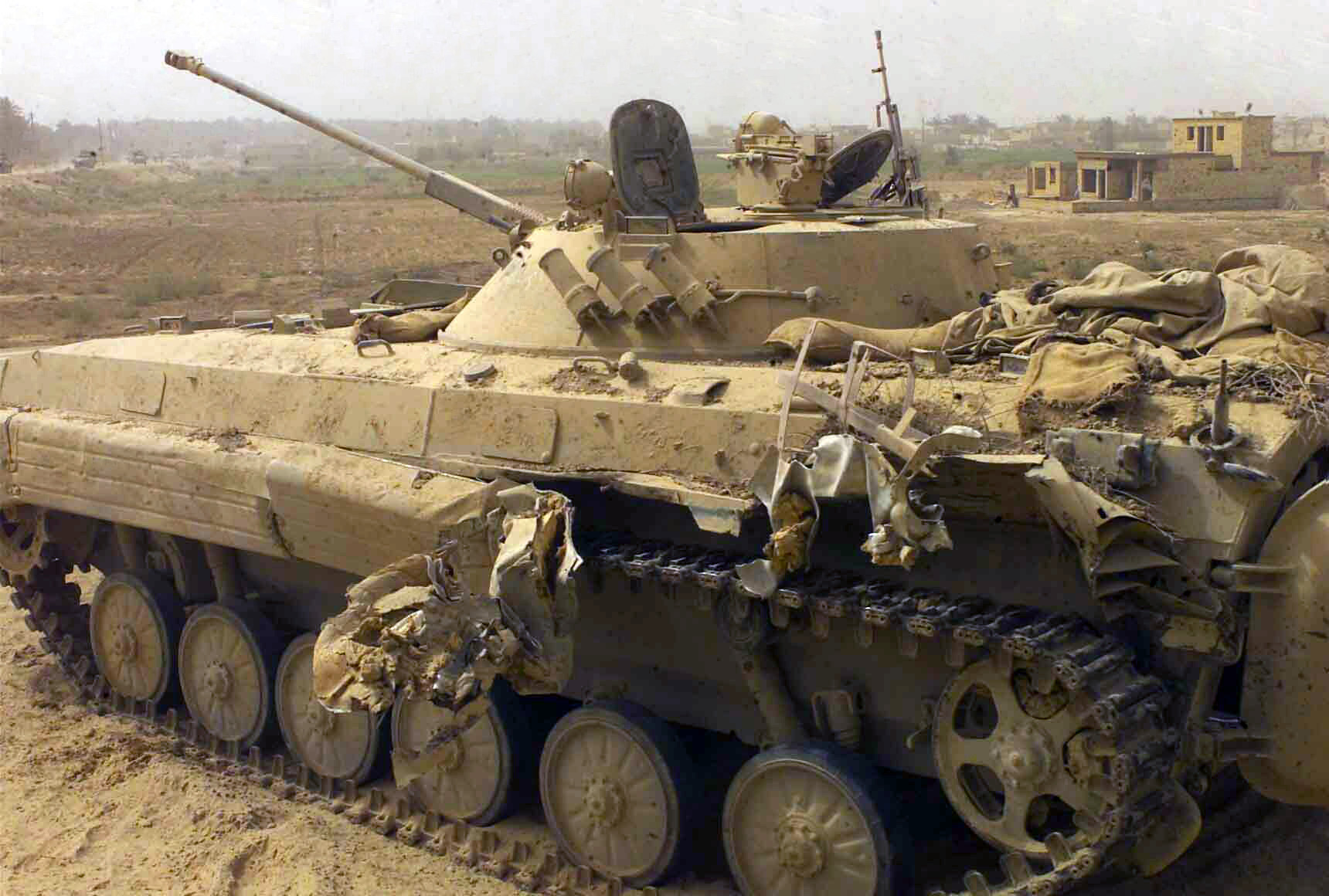
A partially destroyed abandoned Iraqi BMP-2 Infantry Fighting Vehicle sits along a roadside in Northern Iraq, during Operation IRAQI FREEDOM. 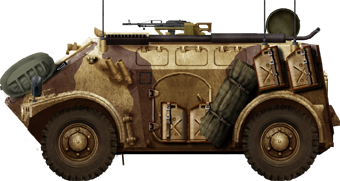
EE9 Cascavel 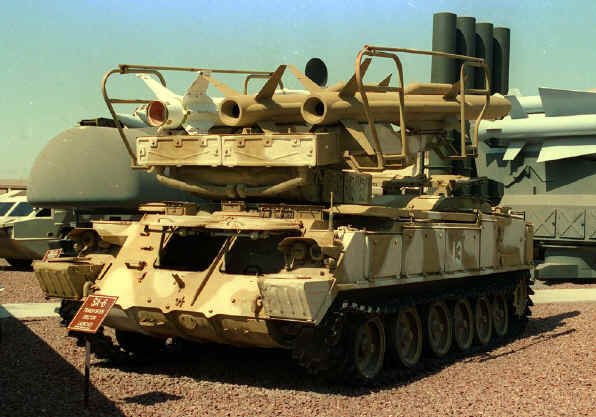
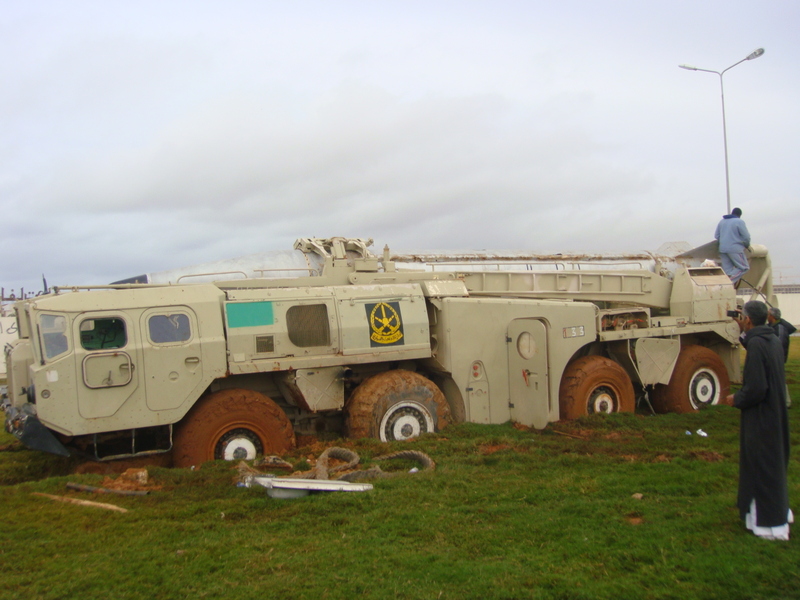

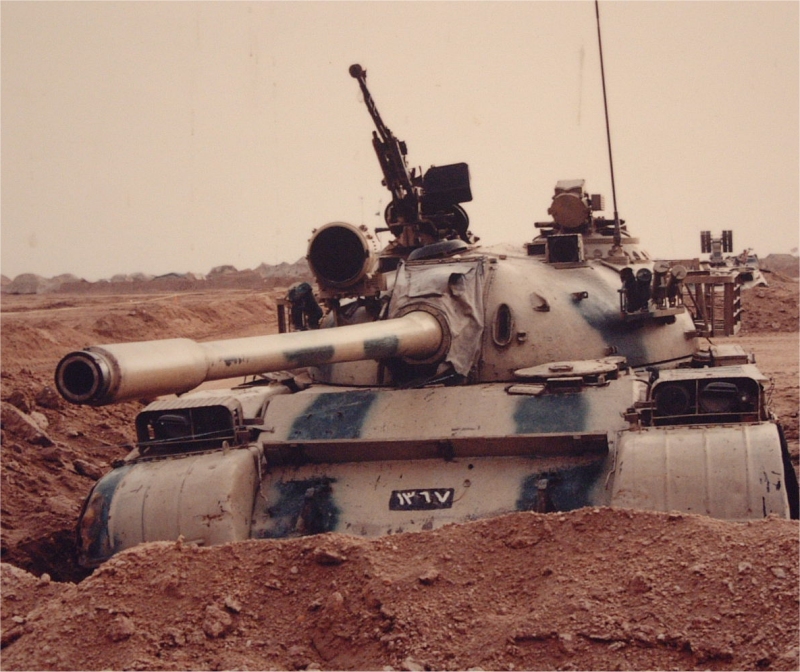
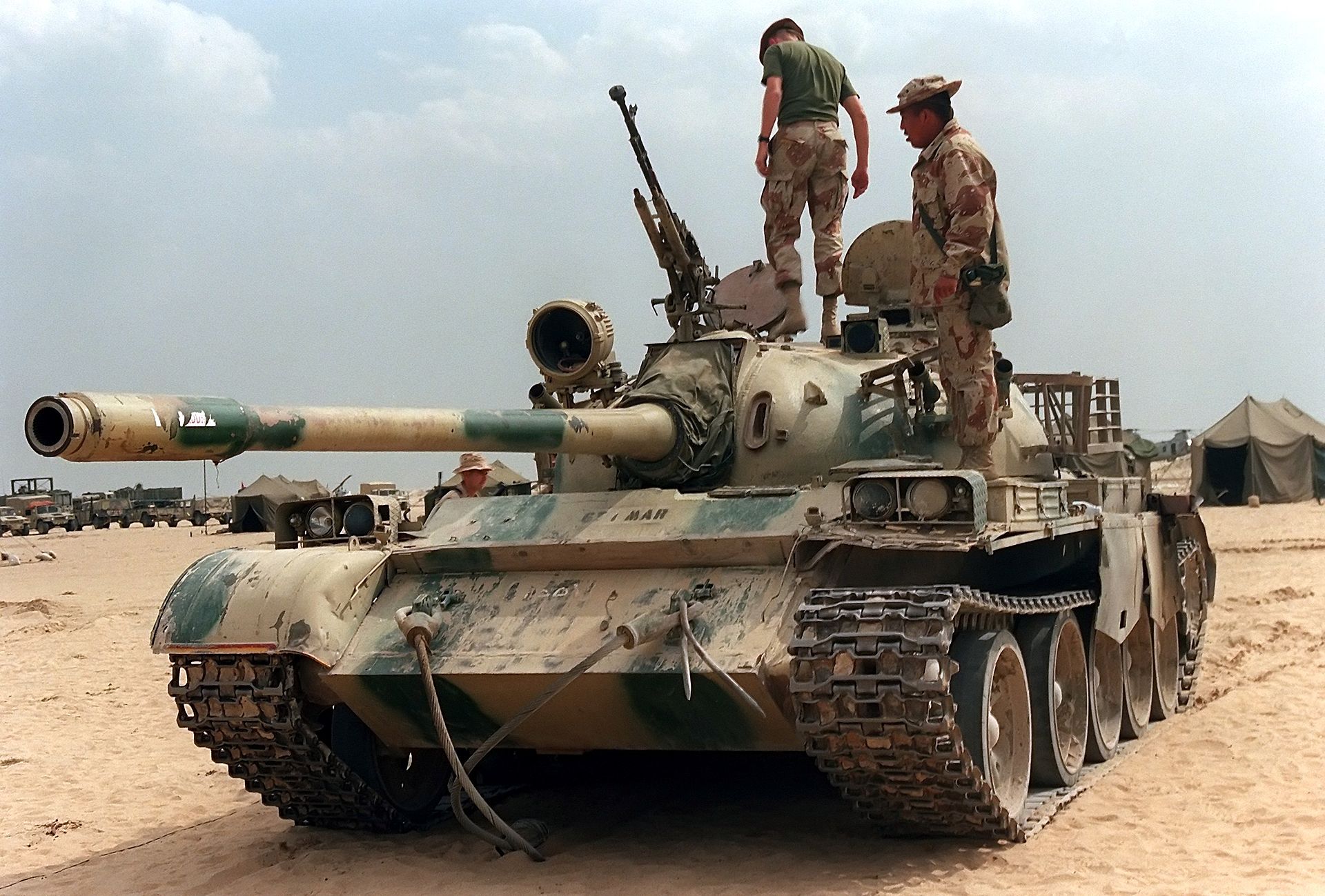

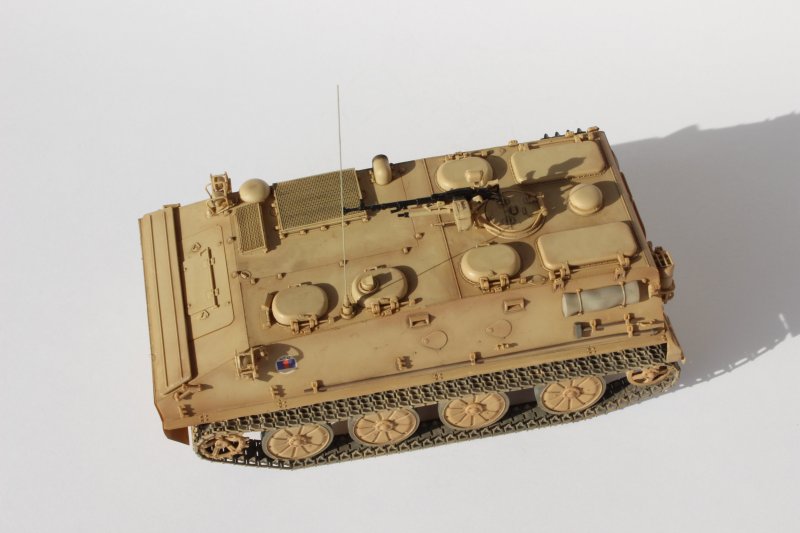
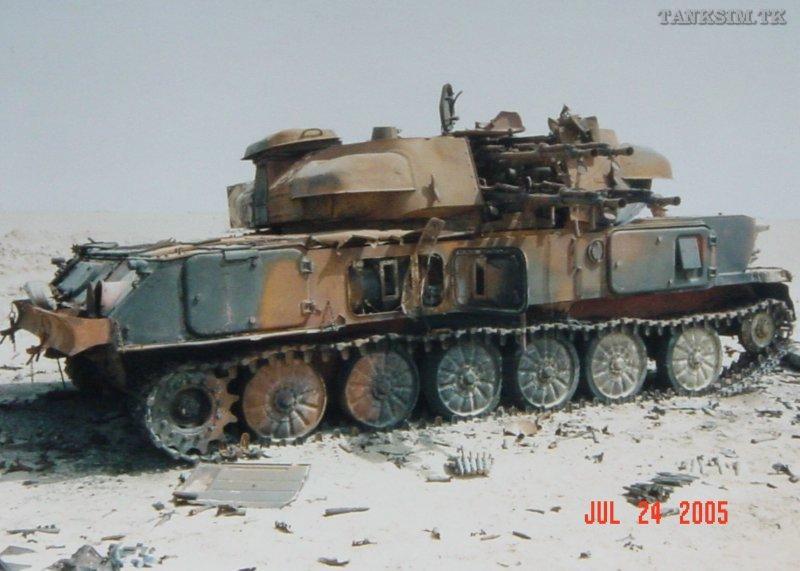
The Iraqi Revolutionary Army 1965 to 1991
One of the most infamous armed forces in recent history; it has few if any redeeming features. Other than this it was trounced in 1973 by the Israelis, and totally mangled by Allied forces in 1991. The best equipment should be reserved for Republican Guard units. Only Soviet made equipment was used against the Israelis in 1967.
Iraqi Brigade Headquarters (Commands 4 Battalions)
HQ HQ
Recce Company 1 PT76 or AML90 or ERC90, or EE9 (no recce company in infantry units)
Anti Aircraft Company 2 ZSU57 or 1 ZSU23, 1 SA9 in tank and mechanized units or 2 23AAG, 2 Truck in Infantry units
Mortar Battery 2 Truck, 2 120M or 82M
Note In 1965 may use BTR-50, and T55. From 1968 add BTR60, OT-62 and OT64. In 1975 add T62, in 1980 add BMP-Comd, 1982 add YW531 and T72, and in 1983 Type 69, ERC90 in 1987 and EE9 in 1991. Tank Regiments may use BTR50, OT-62, BMP and YW531 and recce uses PT76. Mechanized Regiments use YW531 or any of the other APCs and Armored Car for Recce Company. Infantry use trucks, these replace all vehicles noted. Armored and Mechanized use 120mm Mortar Batteries, Infantry use 82mm ones. An Infantry unit has 3 Infantry Battalions in trucks, and may add 1 in APC (most likely BTR60). A Mechanized Unit has 3 Mechanized Battalions with one T55 Battalion. Tank units reverse this and may use any tank type.
Iraqi Tank Battalion 1965 to 1991
HQ 1 HQ
3 Tank Companies each 4 Tanks
Note Tank types are listed under the notes for RHQ, T55, T62 and Type 69 were upgraded with extra armour during 1988 – 90,
Iraqi Infantry/Mechanized Battalion 1965 to 1991
HQ 1 HQ
3 Companies each 2 BMP1 or BMP2, 3 Rifle
Or 3 APC, 3 Rifle
Or 3 Truck, 3 Rifle
1 Mortar Battery 1 Truck, 1 82M
Anti Tank Platoon 2 APC, 1 Sagger, 1 SPG-9 (Not BMP equipped battalions)
Note For APC types see the Brigade HQ. Only one vehicle type may be used. If Trucks are used all vehicles noted as APC are Truck. The exception is the Mortar battery, which always has Truck.
Iraqi Special Forces Battalion 1965 to 1991
HQ 1 HQ
3 Companies each 2 BMP1, 3 Rifle
1 Mortar Battery 1 Truck, 1 82M
Note This battalion is a divisional controlled and is used in a number of ways. It is drawn from the best soldiers in the division and forms the backbone of any counter attack force in the defense. In the offense it is used as a spearhead. It has also been used as a field police by being positioned behind weak or demoralized troops to force them to fight. Most members of this battalion are members of the ruling political party.
Iraqi Divisional Anti-Tank Battalion 1965 to 1991
3 Companies each 2 SU-100 or 2 Truck, 2 100ATG (from 1979)
Or
2 Jeep/Harpoon or 2 BRDM2/AT
Note Dates are approximate. Battalion has a mixture of missile and gun companies. Individual companies may be fielded.
Iraqi Artillery Battalion 1965 to 1997
HQ 1 FAO
3 Batteries Towed – 2 Trucks, 2 122H or 155H or 152H
Or
Self-Propelled – 2 GCT or 2 SO122 or 2 SO152, 2 BM-21
Note Divisional units have 122mm, with 1 Battalion of 152mm in mechanized or armored units. These divisions also use one battalion of BM21. Infantry Divisions also have one battery of BM21. All the rest of the gun types are Corps assets. Soviet self-propelled guns appeared in 1984, the GCT from 1987 on in good quantity.
Iraqi Anti-Aircraft Artillery Battalion (Towed) 1965 to 1997
3 Point Defense Batteries 2 Trucks, 2 57AAG or 85AAG or 100AAG
Iraqi Anti-Aircraft Artillery Battalion (Self-Propelled) 1965 to 1997
2 Self Propelled Gun Bty each 2 ZSU57 or ZSU23 or M53/30
1 Launch Battery 2 SA6 or SA8
Note ZSU23 is rare at this level although it maybe in some infantry divisions as a stopgap. SA8 is a recent purchase in very limited quantity use in Guards units only.
Iraqi Engineer Battalion 1965 to 1997
HQ 1 HQ
1 Engr Company 3 Engr, 1 GMZ, 3 APC, 1 IMR
1 Assault Engr Company 1 BRDM1 or 2, 2 GSP, 2 PT54, 2 Truck with 10 Rafts
1 Bridging Company 1 Truck with 5 Rafts, 1 Engr, 1 BTR152, 4 PMP
1 Tech Engr Company 2 Bulldozer, 1 BAT-M
1 Construction Company 4 Dump Truck, 2 BAT-M, 2 Bulldozer
Iraqi Helicopter Battalion
4 Flights 2 Alouette III/SS11 (From 1965) or 2 Mil24 (From 1978) or 2 Gazelle/HOT (From 1982)
Note Individual flights may be used attached to any Headquarters. No helicopter sorties were attempted during the Gulf War 1.
Iraqi Divisional Recce Battalion 1965 to 1997
HQ 1 HQ
2 Scout Company 4 BRDM1 or BRDM2
1 Tank Companies each 2 PT76 or T55 (after 1980)
Note This unit may use French M3VTT or Yugo M60 APC in place of BRDM and may use AML90 or ERC90 in place of PT76.
Large Units:
Tank Division â 2 Tank Brigades, 1 Mechanized Infantry Brigade, 1 Artillery Brigade (3 122mm Towed Howitzer Battalions, 1 122mm Self-Propelled Howitzer Battalion, 1 152mm Towed Howitzer Battalion, 1 Multiple Rocket Launcher Battalion), 1 Anti-Aircraft Battalion (Self-Propelled), 1 Anti-Aircraft Battalion (Towed), 1 Anti-Tank Battalion, 1 Engineer Battalion, 1 Special Forces Battalion, 1 Recce Battalion
Motor Rifle Division â 1 Tank Brigade, 2 Mechanized Infantry Brigades, 1 Artillery Brigade (3 122mm Towed Howitzer Battalions, 1 122mm Self-Propelled Howitzer Battalion, 1 152mm Towed Howitzer Battalion, 1 Multiple Rocket Launcher Battalion), 1 Anti-Aircraft Battalion (Self-Propelled), 1 Anti-Aircraft Battalion (Towed), 1 Anti-Tank Battalion, 1 Engineer Battalion, 1 Special Forces Battalion, 1 Recce Battalion
Infantry Division â 3 Infantry Brigades, 1 Artillery Brigade (3 122mm Towed Howitzer Battalions and 1 Multiple Rocket Launcher Battery), 1 Tank Battalion, 1 Anti-Aircraft Battalion (Towed), 1 Anti-Aircraft Battery (self-propelled), 1 Anti-Tank Battalion, 1 Engineer Battalion, 1 Special Forces Battalion
Air Mobile Brigade â 3 Commando Battalions, 1 Helicopter Transport Battalion
MSH ORBATS
IRAQI ORGANISATIONS 1990-1991 GULF WAR
Sources: I rely on the reference book “The Iraqi Army: Organization and Tactics” produced by the US Army National Training Centre (NTC) in collaboration with the Defense Intelligence Agency (DIA) and published by Paladin Books, Boulder, CO. in 1991. I also used “Certain Victory: The US Army in the Gulf War”; Brig Gen. Robert Scales; Office of the Chief of Staff, US Army; 1993.
Regular Army Corps
Iraqi Corps bear responsibility for administration and logistics as well as combat operations. The corps frequently has operational control over as many as 10 combat divisions. A corps is commanded by a Major General or a Lieutenant General. Iraq deployed three regular army corps (2, 3 and 4) to Kuwait in 1991, while another corps (the 7th) defended southern Iraq west of Kuwait.
Normally a corps may control up to six infantry divisions; one to two mechanised infantry divisions, and one to two armoured divisions. Other units organic to a corps include brigade size or larger artillery and air defence units, a reconnaissance battalion, one or two commando brigades, a field engineer battalion, an army aviation wing, an antitank battalion, a signal battalion, electronic warfare battalion, a chemical defence company/battalion, a supply and transportation battalion, a corps commander guard infantry company, a medical battalion, and an electronic and mechanical engineer battalion. Attached to the corps from GHQ can be an engineer bridging battalion, an antitank gun battalion, a rocket brigade, a Special Forces brigade, and a tank transporter regiment.
Corps Artillery (Brigade)
Each of the corps� artillery battalions (typically three) has 18 122-mm towed howitzers, though in some cases there are 130mm, 152mm or 155mm also. IFA (East German), Tatra (Czech) or ZIL and URAL (Russian) trucks tow the howitzers. Artillery crews carry Tokarev or Makarov pistols. Other enlisted men in the brigade carry AK rifles. There is also a Locating Battalion.
Corps Locating Battalion
Bn HQ: 5 men, 1 medium truck, 1 trailer
3 Locating Batteries:
Battery HQ: 2 men; 1 medium truck, 1 trailer
Sound Ranging Platoon: 12-18 men, 1 truck w/sound ranging gear
Radar Recce Platoon: 10 men, 3 radar, 3 landrover w/trailer
Optical Recce Platoon: 11 men, 2 or 3 laser rangefinders?
Corps Air Defence Artillery (Brigade)
A generic Corps ADA Brigade might consist of one to three battalions of the 57mm S-60 with 18 guns per battalion. The ADA unit may also contain the 37mm M1939, or the ZSU-23-4 in place of, or in addition to, the S-60s. “The Iraqis have demonstrated a high degree of flexibility in employing ADA assets at corps and below. For example, corps may be assigned SA-6/8 units from GHQ for defence of high priority sites and/or units”. Note: SA-2/3 remain the property of the Air Defence Command not the Army.
Reconnaissance Battalion, Corps
Consists of two companies, each equipped with 18 BRDM-2 (6 in each platoon), and 5 BTR-50 command vehicles. Some corps-level reconnaissance battalions, like divisional battalions, may be equipped with French AML M3-VTTs or Yugoslav M-60 APCs.
Field Engineer Battalion, Corps
Not much detail known. An unknown number of EVA and ZIL trucks with barbed wire laying equipment, graders, and GAZ-69 and -63 transport vehicles.
Engineer Bridging Battalion, Corps
Is equipped with MTU-20 scissor bridge vehicles, pontoon bridge vehicles, and 6 GSP ferries.
Chemical Defence Company/Battalion, Corps
Not much detail known. Decontamination trucks, and chemical reconnaissance equipment on GAZ-66 vehicles. Tents for decontamination.
Aviation Wing, Corps
Organised with three to six (usually five) attack, assault, or transport squadrons, equipped with HIP C/H (15-20 helicopters in a squadron), HIND A/D (8-9 helicopters in a squadron), Alouette III (10 helicopters in a squadron), and/or Gazelle (10 helicopters in a squadron). They may also have BO-105 (8-9 helicopters) or Hughes 500 (small numbers for training). The wing may also have a fixed-wing light aircraft squadron of PC-7s or Tucanos. Up to 15 aircraft in a squadron.
Most missions are performed in formations of at least two helicopters. An Iraqi innovation for armed reconnaissance missions saw teams of three helicopters utilised. These teams consist of a Gazelle with HOT missiles, a BO-105 with rockets, and a HIND as a scout.
Antitank Battalion, Corps
Has an HQ element with two trucks and three jeeps. Up to five companies with up to 40 BRDM-Sagger or VCR/TH (HOT) in total.
Rocket Brigade, Corps
Brigades consist of 18 TELs organised into 3 battalions, with three batteries in each battalion and two TELs in each battery. Iraq uses the FROG-7 system on ZIL-135 vehicles.
Electronic Warfare Battalion, Corps
Typical organisation has a Direction Finding Company, an Intercept Company, a Jamming Company, and a Signal Security Unit. Equipment is a mix of Soviet and Western.
Commando Brigade, Corps
Serves as rear-area security and a raiding force on the offensive. May have up to three commando battalions and a service company. Assume similar orbat to Special Forces Brigade.
Special Forces Brigade
These are kept under GHQ or RGFC control normally, while commando brigades are under corps control (presumably for political reasons). Supposedly elite troops.
HQ and Signal Company
Artillery Battalion: 12 105mm towed howitzers
Mortar Battery: 6 120mm towed mortars
Reconnaissance Company: nfi (may just be truck mounted infantry)
AT Company: a dozen 106mm RCLs and ATGMs on jeeps.
Assault Engineer Company: nfi (truck mounted, three platoons presumably)
3 Special Forces Battalions: of three companies of three platoons carried in 70 wheeled vehicles. The naval Special Forces unit may have at its disposal landing craft and amphibious AFVs. Special Forces squads are composed of nine men as opposed to regular infantry squads of ten or 11 men. Each Special Forces squad has two mgs and two rocket launchers.
Regular Army Division
The Iraqi regular army has three basic types of division: armoured, mechanised and infantry. The basic organisational structure of each type of division is similar. They consist of three manoeuvre brigades, divisional artillery, and various combat support units. Typically, a mechanised division has two mechanised brigades and an armoured brigade, while an armoured division has two armoured brigades and a mechanised brigade. The infantry division has three infantry brigades, and a single organic tank battalion. Divisions have not been limited to their “authorised” organisation and may have 6 to 8 brigades under command for specific missions.
Division Artillery
Each of the three (or four) division artillery battalions has three batteries, a HQ and Admin company, a maintenance company, and a service company. Each battery has two firing platoons of 3 tubes for a total of 18 tubes per battalion. Each battery has 12-13 2 � ton vehicles and one � ton vehicle. In an infantry division the artillery is towed (usually Soviet 122mm M1938s or D30s); in an armoured division, it is usually self propelled (often Soviet 2S1); in a mechanised division it is towed and self propelled. Three battalions will provide direct support, one to each brigade in the division. A fourth provides general support to the division under the control of the division artillery staff.
Light artillery batteries are part of division artillery. Normal organisation is one battery per division, but more may be assigned. Most are equipped with twelve 120mm mortars (in three platoons), but others have MRLs such as the 107mm Type 63.
Artillery doctrine is British and Soviet influenced. A general rule is that forward observers will be located with the headquarters of the forward battalions in both attack and defence. Iraqi artillery uses a dedicated artillery net to control fires. Calls for fire are passed up from company observers through the battalion observer back to the battery fire direction centre. The battalion observer can request additional support from division or corps assets.
Field Engineer Battalion
Three Field Engineer Companies and a service company. The engineer battalion of armoured/mechanised divisions also has a bridging tank platoon with several MTU-55 bridgelayers. Each Field Engineer Company has a HQ element (includes engineer recce section) and three Field Engineer platoons. The engineer companies are normally attached to manoeuvre brigades. The battalion is equipped with a number of EVA, ZIL and GAZ trucks. The ZILs are equipped with barbed wire layers. There are some commercial graders and dozers. There may be PMR-3 minelayers.
Armoured Division Air Defence
Armoured Divisions may have one to three AAA Battalions, each with 18 guns and fire control radar. Armoured divisions also have one to three SA-9 battalions. These have a unique organisation consisting of nine SA-9s and nine ZSU-23-4s. There is a single SPAA battalion with either nine ZSU-23-4s or nine BTR-50 mounted AA guns of varying calibres. Some heavy divisions may substitute SA-13s for SA-9s. SA-7/14/16s would likely be organic to the division. Normally there would be 81 per division, organised into 27 three-man teams. This is normally sufficient for 3 three-man teams per battalion.
Mechanised Division Air Defence
Similar to Armoured Division.
Infantry Division Air Defence
Are normally equipped only with AAA and man-portable SAMs. 1-3 AAA Battalions of 18 guns are normal.
Signal Battalion, Division
Composed of a landline company, a radio company (with a tactical VHF jamming platoon and a receiving & transmitting platoon), a service company and an EME company.
Chemical Defence Company, Division
Has a service and supply platoon, a chemical recce platoon (with BRDM RKH), a vehicle decontamination platoon, and a weapons and equipment decontamination platoon.
Commando Battalion/Brigade
As Corps level.
Reconnaissance Battalion, Division
HQ
Service Company
Maintenance Company
2 Reconnaissance Companies: 5 BTR50 at HQ and three platoons each with 6 BRDM2 or similar.
Tank Battalion, Infantry Division only
HQ: 2 cmd tanks; 4 BTR50 cmd
Recce Platoon: 6 BRDM
Battalion Maintenance: 1 T34 recovery vehicle
Bridge Section: 1 MTU-20
3 Tank Companies: HQ: 2 tanks
3 Platoons: 3 tanks
(MBT is T55 or Chinese T59)
Manoeuvre Brigades
Armoured brigade: three armoured battalions and one mechanised battalion
Mechanised brigade: three mechanised battalions and one armoured battalion
Infantry brigade: three infantry battalions
Additionally, each conventional manoeuvre brigade has a supply and transportation company, a HQ and signal company, a chemical platoon, a commando company (3 60mm mortars, 9 RPG-7s), a reconnaissance platoon, and assault engineer company. Infantry brigades have an organic 82mm mortar company with 18 tubes (often broken up with six 82mm mortars per infantry battalion). ).Note: some sources, notably GDW, hold that a mortar platoon with 6 120mm tubes is part of armoured/mechanised brigades.
Mechanised Infantry Battalion
Vehicle Totals: 39 IFV/APC; 4-6 BRDMs (AT); 23-25 2 � ton trucks; 2 fuel vehicles with trailers; 3 field kitchens.
Each battalion consists of: three infantry companies, each containing 12 APCs; one � ton vehicle, and possibly two 2 � ton vehicles; a combat support company; an administration company; a reconnaissance platoon; and the headquarters company.
Each mechanised infantry company has three rifle platoons, and usually has a heavy weapons platoon equipped with two APCs, three 60mm mortars, 12 RPG-7 rocket launchers, and four 12.7mm heavy machineguns.
Each rifle platoon has three APCs and three rifle squads. Each rifle squad contains ten men.
The HQ Company has 3 APCs.
The Reconnaissance Platoon has up to 6 BRDM (4 with ATGM in BMP Battalions).
The Combat Support Company has an antitank platoon with 4 BRDM (AT) and 4 recoilless rifles (no BRDM in BMP Battalions
Armoured Battalion
Note: The Iraqis follow British practice in calling their Battalion-sized armoured units “regiments”.
Vehicle Totals: 35 tanks; 7 APCs; 6 BRDM; 45-50 2 � ton trucks; 8-10 � ton trucks; 2 fuel trucks with trailers; 3 field kitchens.
Each mechanised or armoured brigade armoured battalion consists of three tank companies, each of three platoons, each with three tanks, for a total of 11 in the company (plus one APC). In addition there is an administrative company, a command and support company (with 2 tanks and 4 APCs), and a reconnaissance platoon.
Infantry Battalion
These were of variable size and quality, often of around 500 men. A battalion has three infantry companies, each with three rifle platoons, and a support platoon with 3 60mm mortars , 4 HMGs and 9 RPG-7s.
Republican Guard Forces Command
By August 1990, the RGFC had grown to eight divisions of 30 to 33 brigades. The RGFC had assumed the role of counterattack force late in the Iran-Iraq War. It is an all volunteer force and displays motivation and initiative not found in the conscripts. Many of the men are college students or from the Tikrit area of Iraq where Saddam�s family hails from. The RGFC maintains its own supply system and has priority for all supplies. This results in “pampered” units that are relatively well paid and receive the best food, uniforms, equipment, etc.
Corps units include a SIGINT Brigade with Western and Soviet (in reserve by 1990) equipment; a Signal Brigade; a Medical Battalion; a Field Engineer Battalion; an EME Battalion; a Supply and Transportation Battalion; a Reconnaissance Battalion (organised as above); a Tank Transporter Regiment; a Corps Commander Security Company; an Aviation Wing; an Antitank Battalion; and occasionally attached an Engineer Bridging Battalion; and a Rocket Brigade.
Corps Artillery consists of two Battalions equipped with Western 155mm/45-cal howitzers, one battalion of Soviet 130mm guns and several battalions of MRLs. These Battalions are organised the same as regular artillery Battalions. There is also a Locating Battalion for counter-battery work.
RGFC Air Defence Artillery consists of several battalions of SA-6 and SA-8 systems.
Republican Guard Division
The RGFC in 1990 had two armoured divisions (2nd Medina and 1st Hammurabi), two mechanised infantry divisions (3rd Tawakalna and 5th Baghdad), and at least three infantry divisions (6thNebuchadnezzar, 4th Fao and 7th Adnan). The Baghdad division is a special formation that remained around the Iraqi capital for the duration. In addition there is a Special Forces Division (possibly the 8th or sometimes the 50th or 99th!).
An armoured division has two armoured brigades and one mechanised infantry brigade. A mechanised infantry division has the proportions reversed. An infantry division has three infantry brigades. The Special Forces division has two Special Forces brigades and a marine brigade. However, during the war RGFC divisions often had regular army brigades attached to them.
A RGFC division also has a HQ, division artillery, air defence artillery, a field engineer battalion, an MP company, a signal battalion, a supply and transportation battalion, a chemical defence company, a medical battalion, a reconnaissance battalion, an armoured battalion (in infantry divisions only) and an attached antitank battalion.
Divisional Artillery
Three battalions of 18 155mm SP howitzers (attached to brigades) in heavy divisions. Two battalions each of 18 2S1s. Two battalions each of 18 2S3s.
Infantry divisional artillery includes three battalions of 122mm towed howitzers, and one or two battalions of towed 152mm howitzers and MRLs.
Manoeuvre Brigades
RGFC manoeuvre brigades consist of:
Mechanised infantry brigade � three mechanised infantry battalions, one armoured battalion;
Armoured brigade � three armoured battalions, one mechanised infantry battalion;
Infantry brigade � three infantry battalions.
Additionally, each brigade will normally have a headquarters and signal company, a light artillery battery (12 120mm towed mortars), an assault engineer company (platoon in an infantry brigade), a chemical defence platoon, an evacuation and maintenance platoon (except in an infantry brigade), a supply and transportation company (platoon in an infantry brigade), a reconnaissance platoon (6 BRDM), and a commando company.
It is normal practice for the division to attach an artillery battalion to each brigade for direct support. In heavy divisions this is often equipped with 18 French GCT 155mm or F3 155mm howitzers.
RGFC Mechanised Infantry Battalion
Vehicle totals: 39 BMP-1/2 (there may be one BMP-2 in each platoon); 23-25 2 � ton vehicles; 2 fuel vehicles with trailers; 3 field kitchens.
Three mechanised infantry companies each have 12 BMP-1/2; one � ton vehicle; and two 2-� ton vehicles. The HQ Company has 3 APCs. A reconnaissance platoon has 6 BRDM (up to four with ATGM in BMP battalion). In non-BMP battalions the antitank platoon has 4 BRDM (ATGM) and 4 recoilless rifles. A mortar platoon has six 82mm mortars.
RGFC Armoured Battalion
Has a total of about 44 T72s, 6 BRDMs, and numerous trucks and APCs.
There are three tank companies each with four tank platoons each of 3 T72s. There are two T72s at CHQ and two more at BHQ. A reconnaissance platoon has BRDMs. Note: some sources give RGFC armoured battalions four tank companies for a total of 58 tanks.
RGFC Infantry Battalion
Has three infantry companies of three infantry platoons and a support platoon (with 3 60mm mortars and 4 HMGs). Each infantry platoon has three squads of about ten men equipped with a machinegun and rocket launcher.
Many battalions may be motorised with trucks and some APCs.



